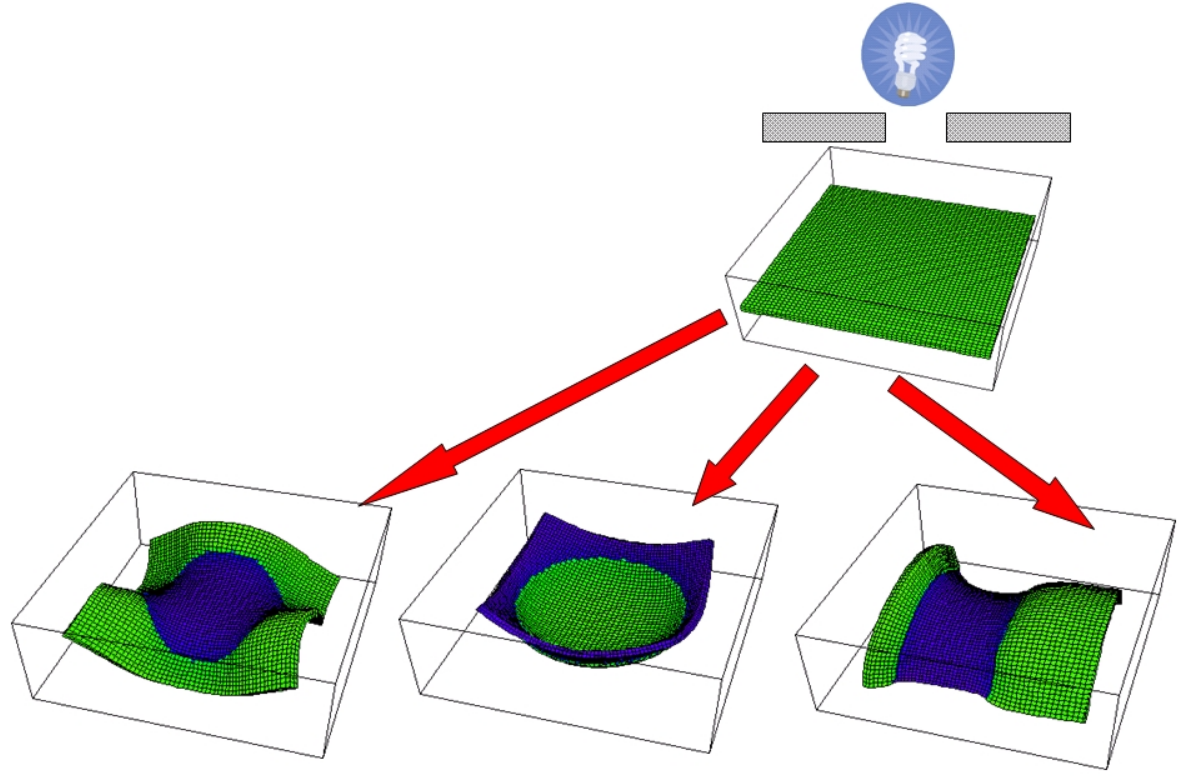’4D printing’ adaptive materials
October 3, 2013
[+]
Researchers from three universities are proposing to add a dimension to 3D printing by developing “4D” materials that can exhibit behavior that changes over time.
Example
of a programmable 4D material: photo-morphing of initially flat
hydrogel sample into various shapes by illumination (credit: Anna C.
Balazs)
Imagine an automobile coating that changes its structure to adapt to a humid environment or a salt-covered road, better protecting the car from corrosion. Or consider a soldier’s uniform that could alter its camouflage or more effectively protect against poison gas or shrapnel upon contact.
With an $855,000 three-year grant from the United States Army Research Office, the researchers from the University of Pittsburgh’s Swanson School of Engineering, Harvard School of Engineering and Applied Sciences, and the University of Illinois plan to manipulate materials at nano and micro levels.
The goal: produce, via 3D printing, materials that can modify their structures over time at the macro level.
Adaptive biomimetic composites
“Rather than construct a static material or one that simply changes its shape, we’re proposing the development of adaptive, biomimetic composites that reprogram their shape, properties, or functionality on demand, based upon external stimuli,” said principal investigator Anna C. Balazs, the Robert v. d. Luft Distinguished Professor of Chemical Engineering in Pitt’s Swanson School of Engineering and a researcher in the computational design of chemo-mechanically responsive gels and composites.
“By integrating our abilities to print precise, three-dimensional, hierarchically-structured materials; synthesize stimuli-responsive components; and predict the temporal behavior of the system, we expect to build the foundation for the new field of 4D printing.”
Co-investigators are Jennifer A. Lewis, the Hansjörg Wyss Professor of Biologically Inspired Engineering at the Harvard School of Engineering and Applied Sciences and an expert in 3D printing of functional materials; and Ralph G. Nuzzo, the G. L. Clark Professor of Chemistry and Professor of Materials Science and Engineering at the University of Illinois, a synthetic chemist who has created novel stimuli-responsive materials.
Lewis added that current 3D printing technology allows the researchers to build in complicated functionality at the nano and micro levels within specific areas of the structure. “Composites that can be reconfigured in the presence of different stimuli could dramatically extend the reach of 3D printing.”
The research will use responsive fillers embedded within a stimuli-responsive hydrogel. Nuzzo says this opens new routes for producing the next generation of smart sensors, coatings, textiles, and structural components.
“The ability to create one fabric that responds to light by changing its color, and to temperature by altering its permeability, and even to an external force by hardening its structure, becomes possible through the creation of responsive materials that are simultaneously adaptive, flexible, lightweight, and strong. It’s this ‘complicated functionality’ that makes true 4D printing a game changer.”
(¯`*• Global Source and/or more resources at http://goo.gl/zvSV7 │ www.Future-Observatory.blogspot.com and on LinkeIn Group's "Becoming Aware of the Futures" at http://goo.gl/8qKBbK │ @SciCzar │ Point of Contact: www.linkedin.com/in/AndresAgostini
 Washington
Washington